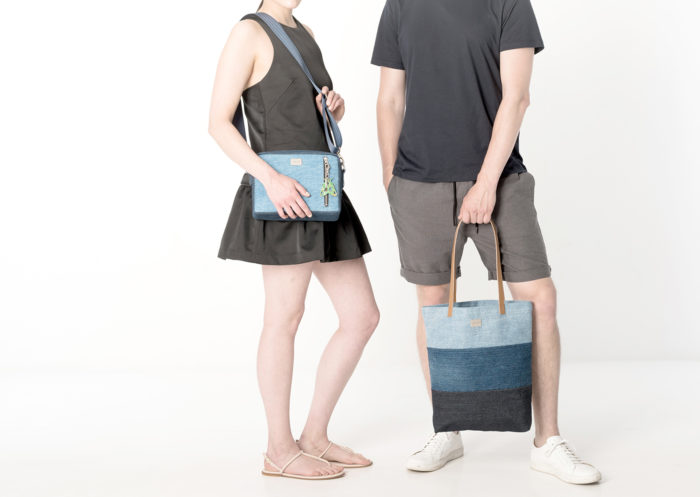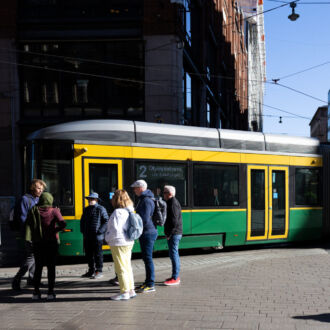Designer clothes made of old sails, dishwashing brushes made from plastic bags, agricultural nutrients from batteries, and chimneys made from slag: In 2017, a record 99 percent of Finland’s municipal waste was put to further use.
Forty-one percent of refuse was recycled as materials, while 58 percent was incinerated for energy. As waste usage has become more efficient, the number of garbage dumps in Finland has dropped significantly. More than 2,000 have been shut down over the years; at the time of writing there are fewer than 350 left.
Finland is still working to boost its material recycling rate. Burning trash for energy is not without problems: it produces ash and slag, which can’t usually be used for anything else. These by-products must be stored and periodically agitated, which consumes electricity.
Nearly all materials can be recycled

In Helsinki, all buildings with at least 20 flats offer collection receptacles for biowaste; paper; cardboard and paperboard; glass; and small metal items; in addition to general rubbish. Many housing associations also collect plastic. Recycling containers are located next to the rubbish bins in each courtyard.Photo: Tero Sivula/Lehtikuva
“Paper collection began in Finland in the 1910s,” says Sirje Stén, an advisor at the Ministry of the Environment. “Rags and old clothes were collected even before that. Clothes were mostly made of cotton, which was used to make paper. Glass and particularly metal are valuable materials, and have been collected in Finland for a long time.”
Biowaste collection in its current form began in Finnish cities in the 1990s, followed by plastic in the 2010s.
Municipalities and cities are responsible for gathering various types of refuse. In Helsinki, for instance, all buildings with at least 20 flats must offer collection receptacles for biowaste; paper; cardboard and paperboard; glass; and small metal items; in addition to general rubbish. Many housing associations also collect plastic.
Batteries and lightbulbs can be returned to any shop that sells them. Other household waste, such as furniture, electrical appliances or renovation scrap, is taken to recycling centres. A collection system for textile waste is under development.
Recycling works when it’s easy

Nearly 100 percent of beverage containers with deposits are returned in Finland. The collected plastic, glass and metal becomes new cans and bottles. Photo: Anna Ruohonen
“The most common obstacles to recycling are that it’s considered difficult, the recycling points are far away, and there’s not enough space at home for it,” says Asta Kuosmanen, chief specialist at the Martha Organisation, an NGO that promotes wellbeing and quality of life in the home. So we have to make recycling as simple and rewarding as possible.
Collection points should be as close as possible – preferably in each building’s courtyard. Even a small home can fit compact separate containers for various sorts of waste, so that collecting is hassle-free.
“Advice and communications also have an impact on recycling: consumers must be told about the concrete benefits of recycling and how the material is used,” Kuosmanen says.
“The Finnish bottle deposit system on excellent; we collect almost 100 percent of beverage containers,” says Sirje Stén. They are used to produce new cans and bottles. Other recycled glass is used to make jam jars, glass bottles or fibreglass. Glass is also used in civil engineering projects.
Most paper and paperboard is recycled in Finland. Collected paper is used to manufacture newsprint and paper towels, while paperboard is turned into inserts for rolls of paper towels or cloth.
Circular economy spurs opportunities

No kitchen is too small for recycling. Cartons can be flattened and compacted so they take up less space.Photo: Mirva Kakko/Otavamedia/Lehtikuva
In a circular economy, production, consumption and services are arranged as sustainably as possible. The aim is to keep items and materials in circulation as long as possible by maintaining, repairing, reshaping and re-using them. One way to minimise the creation of waste is to avoid unnecessary packaging and single-use products.
When waste is produced, it is gathered separately and used as efficiently as possible. This offers business opportunities as companies come up with new ways of exploiting the collected material. In Finland, broken-down tractors that can no longer be fixed are taken apart for spare parts, old roofing material becomes raw material for asphalt, and coffee grounds make a good base for growing mushrooms.
Some Finnish restaurants produce meals out of donated surplus food. Restaurant and shop managers use apps to sell leftover food at discount prices after lunchtime or as their “best before” dates approach. Some groups distribute surplus food for free to those in need, or serve meals made from leftover food for free or at nominal prices. In Helsinki there are also experiments with public refrigerators where anyone can leave unneeded food or take food.
Brand-new second-hand apparel

Finnish company Globe Hope makes design clothing and accessories from surplus materials.Photo: Globe Hope
Clothing in good condition has traditionally been given away or sold at flea markets or thrift shops. Online services for selling second-hand clothes have sprung up, making it as easy as possible to sell and buy.
Finnish companies are putting unsalable textiles to use: Remake Ecodesign “upcycles” second-hand clothes into mass-produced apparel collections, while Globe Hope makes design clothing and accessories from surplus materials such as old army textiles, sails and advertising materials. Pure Waste converts textile-industry waste into raw material for a new clothing industry and readymade attire.
There are also pilot projects under way, in which new thread and cloth is made from worn-out clothes and other waste fabric. Finland’s goal is that 50 percent of municipal waste will be recycled in 2020 and 55 percent by 2025.
By Anna Ruohonen, June 2019







